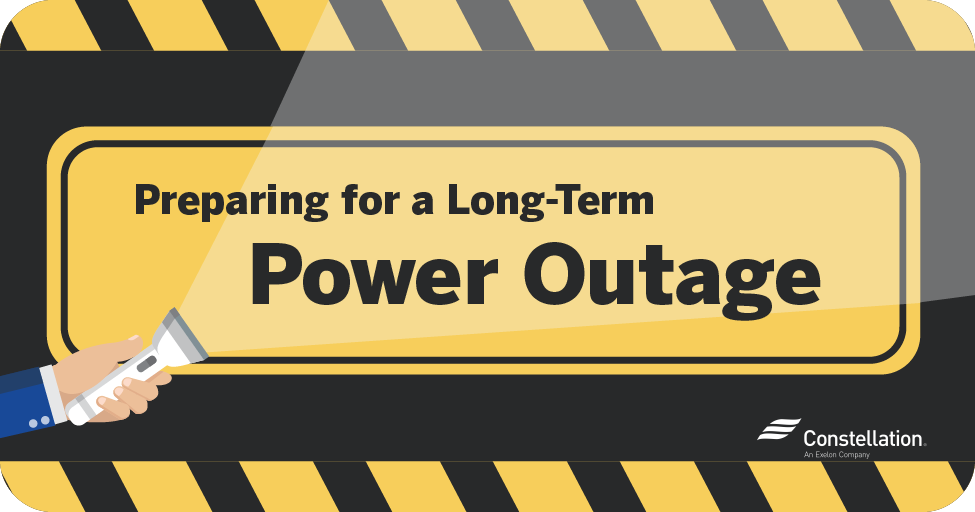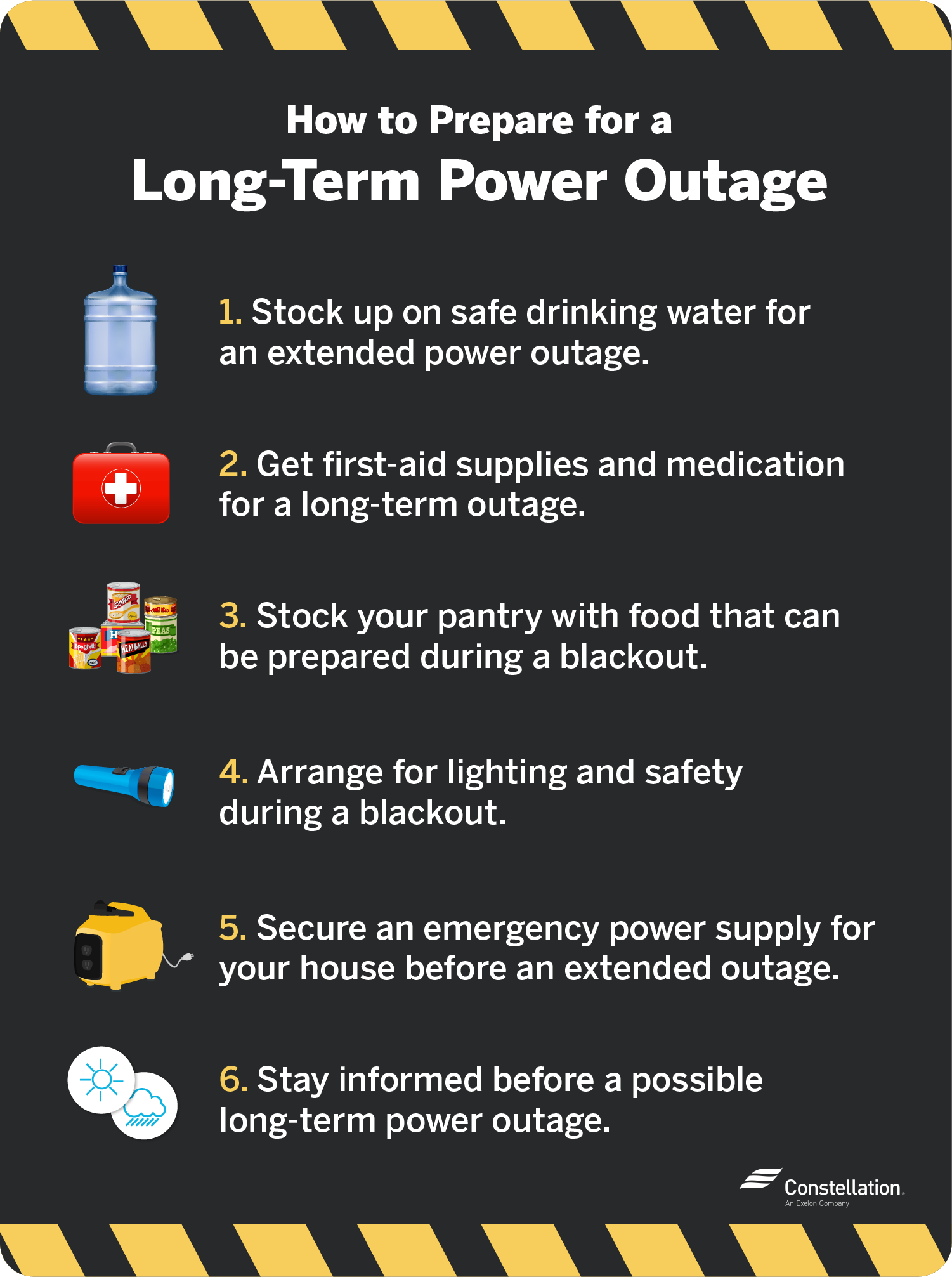
- Category:
Disaster Preparedness -
Last updated:
September 10, 2020
How to Prepare for a Long-Term Power Outage
Power outages can be unpredictable — and are unfortunately common — events, affecting more than 36 million Americans in 2017 alone. If a blackout lasts for a long time, it can create many challenging and potentially dangerous situations for families. That’s why it’s important to be prepared for a long-term power outage.
Common reasons for an extended power outage
A long-term, or extended, power outage is a little- or no-notice outage that affects a large geographic area for a long period of time. The worst of these events are known as catastrophic power outages. Unlike brownouts, these types of outages can cause severe problems in local drinking water and wastewater systems, healthcare systems and many other public sectors.
Common causes of long-term or catastrophic power outages include:
- Hurricanes
- Floods
- Wildfires
- Earthquakes
- Solar storms
- Cyber or physical attacks
How long do power outages typically last?
According to the U.S. Energy Information Administration, in 2016 the average American electricity customer was without power for a little over four hours, if you include major events. That being said, how long a power outage will last depends on a variety of factors, such as the cause of the outage and the state it occurs in.
How likely is a long-term power outage?
Due to unpredictable causes, determining the likelihood of a major power outage is difficult. One of the most severe power outages to hit America came as recently as 2012 in the wake of Superstorm Sandy. Its high winds and storm surge devastated coastal areas in New York and New Jersey, resulting in tens of billions of dollars in damage. Many areas were without power for more than a week.
Storms like Sandy and other catastrophic events threaten the country’s power grid year after year. The risk of suffering a big electrical outage is real and ongoing. That’s why learning how to prepare for a power outage is something each of us should do.

What to do before a long-term power outage
Getting through an extended or catastrophic blackout safely largely depends on preparation. There are certain necessities for a power outage you’ll want to have on hand. Taking action now can protect you and your family later.
Stock up on safe drinking water for an extended power outage
Depending on your type of home and how you get your water, you may not have access to the tap during a long-term power outage. For example, well water that’s pumped electrically won’t be accessible during an outage. Multilevel apartment buildings will also likely be without water since they usually use their own electric pumps.
Each person requires approximately 1 gallon of drinking water per day; that doesn’t include water for cooking and cleaning. It’s vital to have a plan in place should a major power outage occur. If you won’t have tap access during a blackout, you can gradually build a reserve supply of bottled water. You could also purchase tub liner bags for extra water storage.
Get first-aid supplies & medication for a long-term outage
Since transportation and availability may be limited during a blackout, spare medications and a first-aid kit are essential when preparing for a big power outage. Although prescriptions are generally filled on a monthly basis, you can try contacting your insurance about filling your most important ones in advance. If you have medical devices that run on electricity, be sure to talk with your doctor about what to do in case of an outage.
First-aid checklist for extended power outages
Preassembled first-aid kits are useful in a pinch, but they may not include all the things you need in a power outage. Constructing your own first-aid kit is the only way to ensure that you’ll have everything you need to meet your household’s specific needs.
Here are general items to include in a first-aid kit for an extended power outage:
- Bandages
- Antibiotics
- Gauze pads
- Butterfly stitches
- Cold compress
- Thermometer
- Pain relievers
- Disposable gloves
Visit the American Red Cross for a comprehensive list of items to include in your first-aid kit.
Stock your pantry with food that can be prepared during a blackout
Once an extended power outage begins, stores will be flooded with people looking to stock up on food. That’s why developing an emergency pantry ahead of time is essential to long-term power outage survival. The best foods to store for catastrophic events are calorie-dense, nonperishable items that require little preparation.
Some common food items to include on your power outage checklist are:
- Powdered milk
- Oatmeal
- Cereal
- Granola bars
- Crackers
- Nuts and dried fruit
- Pasta
- Rice
- Beans
- Bouillon cubes
- Canned vegetables (plus a manual can opener)
- Dried or canned meat
- Seasonings and spices
- Instant coffee and tea
- Baby food
Consider purchasing a few of these items each time you go shopping or buying them in bulk from a wholesaler.
Arrange for lighting and safety during a blackout
Another important thing to consider is how you’ll keep your home lit during a long-term power outage. Since candles create unnecessary fire hazards, the better option is to use battery- or solar-powered headlamps, flashlights and lanterns. You’ll also want to install battery-powered smoke and carbon monoxide detectors.
Secure an emergency power supply for your house before an extended outage
If your budget allows, an alternative power supply can be useful for long-term power outage survival. Items such as generators and solar panels can power your refrigerator, run your well pump and better help you return to a “normal” routine during a blackout.
Choosing the right emergency generator for your home
Finding the right emergency generator for your home may require some time and research. But if you can afford one, it can be a valuable part of your power outage preparation.
Start by determining your needs as a household and shopping around from there. Have a big house with a lot of stuff to power? Consider a generator with a high maximum output. Plan on drawing power consistently? Look for one with a high continuous operation time. Whatever your choice, be sure to stock up on the appropriate fuel and remember to never run your portable generator inside.
Stay informed before a possible long-term power outage
Although power outages are often unpredictable, it is possible to track some of the events that cause them. Use your cell phone or computer to sign up for local weather alerts and warning systems. You’ll be automatically notified of approaching weather hazards, which will give you time to properly prepare your home and surroundings. It may also be wise to have a portable charging pack that can power your cell phone during a long-term blackout.
What to do during a long-term power outage
Knowing how to prepare for a power outage is just the first step in keeping your family safe when the grid goes down. Once you’re in the middle of an extended or, worse still, a catastrophic power outage, you’ll need to know how to safely provide basics like food and warmth without the benefit of electricity.
Cooking during a power outage
Gas stoves may continue to work during a long-term power outage. But electric stoves won’t, and that means they’ll need to be temporarily replaced. Some good alternatives to a traditional stove are fireplaces, solar ovens, wood stoves and gas or charcoal grills. Whatever your choice, just be sure to stock up on the appropriate fuel.
Heating your home during a power outage
Keeping your home warm will be a necessity if you experience a catastrophic power outage over winter. An alternative heating source — such as a fireplace, wood stove or kerosene heater — along with insulated, non-cotton clothing can help you beat out the cold temperatures. Low-temperature sleeping bags and emergency blankets for each member of your household may also be helpful when preparing for an extended power outage. Your community may also have warming centers you can visit in extreme cold.
Note: Attempting to heat your home with a gas oven or stovetop may lead to carbon monoxide poisoning and is not advised.
Staying cool during a blackout
You’ll want to have a plan for keeping cool in the event of a long-term power outage over summer. Keeping window shades and blinds down will block out excess heat from the sun, while lightweight, cotton clothing will help you limit perspiration. A battery-operated fan is also an essential when preparing for a power outage. Some communities may even offer cooling centers powered by generators.
Sanitation & personal hygiene
Toilets can use anywhere from a little over a gallon of water to upwards of 8 gallons of water per flush. The average shower consumes nearly 16 gallons. If you know you’ll be without water access during a long-term power outage, it’s important to have a backup plan in place.
How to stay connected and informed during an extended blackout
Whether you need to report an outage, check in with family or call for emergency assistance, establishing a line of communication is essential to long-term power outage survival.
Keeping your cell phone charged and available is helpful. But that shouldn’t be your only means of outside communication during a long-term power outage. A solar or battery-operated radio will allow you to listen for news and updates that would otherwise be unobtainable. You can also collaborate with neighbors and other community members to develop a strategy for communicating information without the use of electricity.
What to do after an extended power outage
The government recommends that you throw out any food that’s been exposed to temperatures of 40℉ or higher for more than two hours. You should toss anything that smells or looks off.
That goes for medicine that needs to be refrigerated, too, unless the label says differently. If it hasn’t been refrigerated for more than a day, the government recommends that you throw it away. But if a life depends on taking the medicine and you can’t get a replacement right away, consult your doctor or pharmacist for instructions.
When a power outage occurs, there’s often no telling how long it could last. Even a few hours without electricity can be difficult to get through if you’re unprepared. And it would be much harder to endure a catastrophic power outage without enough planning. But by following these power outage tips and being proactive in your preparation, you can put yourself and your family in a much better position during a long-term blackout.




